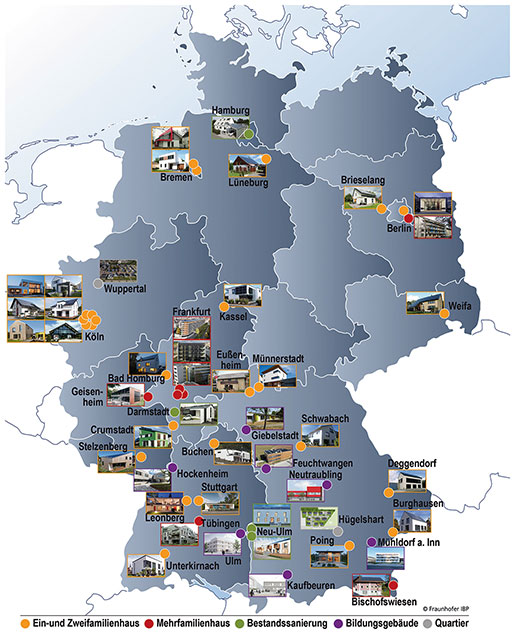Based on the Berlin pilot project (Efficiency House Plus in Berlin) the evaluation and dissemination of the "Efficiency House Plus standard" was set as a goal for the research initiative of the Federal Ministry of Construction. The Efficiency House Plus standard in residential units is achieved if a building’s energy performance fulfils the following criteria: the verified energy demand of a building must be negative, both in terms of the final/delivered energy demand and the primary energy demand (based on an assumed household electricity demand of 20 kWh/m²a).
In the scope of the accompanying research work done by Fraunhofer IBP in relation to this initiative, the design values of all 37 model projects comprised in the network were verified using the software "Effizienzhaus Plus Rechner", which was developed by Fraunhofer IBP. During a 2-year monitoring phase following the commissioning of the buildings, the measured data was analyzed and evaluated in a cross-comparison. The results have been presented on the Internet platform of the German research initiative "Zukunft Bau" (Future construction) www.forschungsinitiative.de/effizienzhaus-plus (only in German) and in professional events, leaflets/ brochures and network meetings.
With only a few exceptions, the Efficiency House Plus standard was found to have been achieved for both single-family homes and multi-family apartment blocks. The thermal insulation quality of the buildings was approximately 40 percent better than the value of the EnEV reference building (*EnEV: the German Energy Saving Ordinance). The photovoltaic surface that is required to achieve the Efficiency House Plus standard ranges between 0.33 m²PV area/m²floor space (MFH) and 0.46 m²PV area/m²floorspace (SFH). In the first year of measurements, the final/ delivered energy use of the buildings was on average about 10 percent higher than predicted, compared to the values calculated according to German standard DIN V 18599 and the requirements specified in the Efficiency House Plus standard. This average could be reduced to one percent in the second year of measurements. Regarding the photovoltaic yields, predicted and measured data was found to be in good agreement. The monitoring process proved to be a suitable instrument for determining optimization potentials.
In the study "Potenzielle Beiträge der Effizienzhaus-Plus-Gebäude zum Klimaschutzprogramm der Bundesregierung" [Potential contributions of Efficiency House Plus buildings to the Climate Protection Program of the German Federal Government] Fraunhofer IBP could point out that it is possible to achieve the following averaged annual CO2 reduction potentials in Germany:
- in 2030 - 6 million t/a (a share of 8 percent in the goals of the 2030 Climate Protection Plan)
- in 2050 - 14 million t/a (a share of 33 percent in the goals of the 2050 Climate Protection Plan)
DOWNLOAD of study [PDF, 78.6 KB] (Only German)
These estimated figures are based on the assumption that the Efficiency House Plus standard has reached a market share of 15 percent in the new construction sector and in the refurbishment of existing buildings (empirical value provided by the prefab housing industry).
In 2017, the research initiative was extended to include pilot projects on educational buildings. The planning, implementation and monitoring of a total of seven projects were and are being funded. The Efficiency House Plus standard for educational buildings corresponds to that for residential buildings, with the exception that the user electricity requirement has been adjusted to a heated net floor area (NFA) of 10 - 15 kWh/m². The role of the IBP researchers in these projects is to cross-evaluate the planning and monitoring data. The preliminary results are documented in the German brochure “5 Jahre Bildungsgebäude im Effizienzhaus Plus-Standard” (5 years of educational buildings in the Efficiency House Plus standard) and were presented at the Bau 2021 trade fair (only German) and at the 10th annual celebration of the Efficiency House Plus initiative (only German).
Partnering institutions in the accompanying research include:
- Berliner Institut für Sozialforschung GmbH (BIS) (Accompanying research phase 2 to 3)
- Com.X Institut für Kommunikations-Analyse und Evaluation (Accompanying research phase 4)
Funding was received from the German Federal Ministry for Housing, Urban Development and Construction (BMWSB), represented by the German Federal Institute for Research on Building, Urban Affairs and Spatial Development (BBSR) under reference no. FKZ: SWD – 10.08.18.7-11.59 | SWD – 10.08.17.7-13.56b | SWD – 10.08.17.7-15.44. | SWD – 10.08.17.7- 20.12
